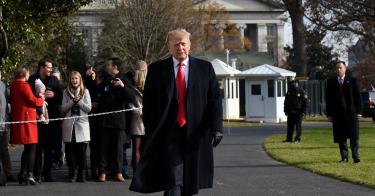It’s $125 billion.
That’s how much more the federal government will have to borrow in fiscal 2020 just to maintain its current level of discretionary spending.
It equates to a $384 bill for every person in the United States. With the national debt already approaching $22 trillion, that’s more than taxpayers can afford.
Thankfully, it doesn’t have to happen. In October, President Trump sent a message to his cabinet: “Get rid of the fat, get rid of the waste.” The president’s statement was more than just hyperbole. He backed it up with a policy directive, telling agencies to cut 2020 budgets by 5 percent (a total of at least $62 billion).
To be clear, cutting 5 percent out of a small piece of the budget pie will not solve the country’s debt problem. But it could be a catalyst for reforms where the real spending occurs: in entitlement programs such as Social Security and health care. Reforming these programs will be necessary if Congress is to change the long-term budget trajectory.
The Budget Control Act of 2011 (BCA) tried to cap defense and non-defense discretionary spending through FY 2021. But Congress subsequently amended the law three times, raising spending by $440 billion. The most recent deal, double the size of the previous two combined, caused the $125 billion “funding cliff” that the country is racing toward.
Some members of Congress assume there will be a fourth cap-raising deal that would allow them to avoid the cliff by plunging deeper into deficit spending. Adopting Mr. Trump’s plan could save taxpayers from that fate.
There are several ways to meet the president’s 5 percent savings goal. Some would require buy-in from Congress, while others could be pursued by the administration without legislative help.
The best option would be to stick to the BCA, without compromising national defense. Doing so would double the president’s proposed FY 2020 savings. If Congress removed the separate defense and non-defense caps in favor of one total spending cap, it would give lawmakers the flexibility to prioritize defense spending and relieve the pressure for another budget deal.
Another option would be to pursue a rescissions package, which takes back money previously appropriated by Congress, but not actually spent by agencies. While a president can initiate a rescission, it must be approved by Congress for it to take effect.
The president tried this approach earlier this year. First reports had him contemplating a rescissions package of $60 billion. However, his eventual request to Congress totaled just over $15 billion. The package passed in the House but failed in the Senate, mainly because senators wanted to reserve those savings for use as gimmicks to pay for new spending later.
The budget outlook today is grimmer now than it was six months ago. Rescissions should be part of any strategy to cut discretionary spending.
Finally, there is a third option the president could pursue, with or without congressional approval. The Executive Branch can implement administrative rule changes that carry budgetary effects.
For example, Agriculture Secretary Sonny Perdue could direct states to stop applying for work-requirement waivers that apply to able-bodied adults without dependents in the food stamp program. Thirty-six states have full or partial waivers, which are intended to give recipients more time to find work in times of high unemployment.
But unemployment now stands at a 48-year low. With only 3.7 percent unemployment, there isn’t a critical need for the waivers. Discontinuing them could save taxpayers over $8 billion per year. Combining this and other administrative proposals could get Trump to his 5 percent goal.
For the economic well-being of the country, the president and Congress must find ways to get the mounting national debt under control before it’s too late. Cutting discretionary spending by 5 percent is an important first step toward achieving that goal.
This piece originally appeared in The Washington Times



